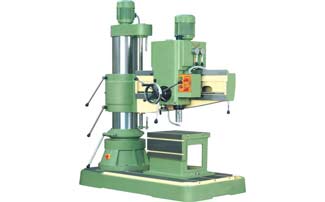Whether you run an engineering workshop or an industrial job site, the radial drill machine is a powerful tool. However, there are several things that you should keep in mind when using one.
The base of a radial drill machine is made from graded cast iron that has high compressive strength and can absorb vibrations. It can also rotate 360 degrees.
Radial Drill for Simple Holes
Radial Drill Machines can be used for the creation of simple holes. These are often utilized when the component size is large in terms of height. They cannot fit their structure in the Machine vice hence a Radial drill machine is required to carry out the drilling operations.
A radial drill machine includes a base, an inner and outer column and a radial arm. The radial arm can rotate 360 degrees and can also be lifted or lowered. This provides the machine with substantial versatility and convenience, especially when working on parts that are too large to move easily.
Designed for Complex Patterns
Radial drill machines are designed for drilling and have features that allow them to perform many specialty functions. They are used in a variety of applications and can handle high-volume production work. They are a great addition to any workshop and will boost productivity.
These machines are also able to perform reaming and can enlarge previously punched holes in the work piece. They can also chamfer the edges of the workpiece to remove burrs. They are able to move the drill head and spindle to meet the needs of each job, so they can be used for different types of processing.
The radial drill machine has four parts: the base, the radial arm, the rack and pinion system, and the drill head. The radial arm is a swinging arm that can be moved up and down on the body of the machine.
Reaming
Reaming is a process that can enlarge holes punched by a drill. It is done to improve surface finish and eliminate any unwanted ridges that might remain in the hole. Reaming also removes burrs from the drilled part, which is important for the quality of the finished product.
The radial drilling machine is one of the most versatile tools in production and manufacturing centers. It is capable of punching through or drilling blind holes as well as reaming through and enlarging previously punched holes. It also has the ability to rotate and swivel, making it possible to work on complicated and twisted parts.
The radial drilling machine has four main components; the base, the inner and outer columns and the radial arm. The radial arm allows the drill head to move in a 360-degree rotation and moves up and down on the column. The power to operate the machine comes from the spindle that holds the drill chuck.
Versatility and Precision
Besides drilling holes, radial drill machines can also be used for taping, reaming, spot facing and countersinking. They are used in various manufacturing processes, such as metal and woodworking, construction, and metallurgy.
The most common use of a radial drill machine is for drilling large-sized parts. They have a heavy duty frame that eliminates vibration. They also have a power-feed capability, which is useful when drilling parts that are very thick or hard.
A radial drill machine can create a shallow, enlarged cylindrical cut-out so that the head of a screw bolt or fastener can sit flush with a surface. Unlike counterbores, which are cylindrical, countersinks have a tapered edge. This allows for easier insertion of screws and washers. It is also more accurate than using a drill.
One of the most versatile machining equipment, radial drill machines have advanced to allow for spot facing as well as punching and reaming holes. They can also be used to enlarge blind or drilled holes.
Spot facing is a machining process in which the landing surface of a hole is milled to flatten it. This is achieved with a cutter that has cutting lips perpendicular to the hole axis with no relief angle. A counterbore cutter is traditionally used for this in manual machining (although not so much in CNC machining) while endmills are employed for larger planar surfaces that need to be spot faced.
This allows for the insertion of a larger tool without having to flip the part over. This cuts down on production time significantly as the machine does not need to be repositioned.






